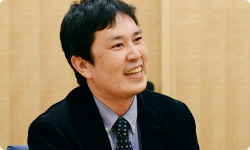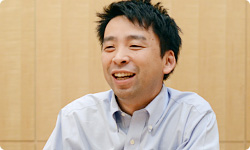If we were making a regular game, we’d be struggling to come up with ideas right up to the very end, but with Street View, it was like we had lots of material from the very start.

I feel that a service that was used as a tool will, through the entertainment device that is Wii U, be reborn as something new. Then more people will take an interest, and there will be a possibility that the way we interact with maps will change.
Which will give rise to ways of using and enjoying Street View that we never imagined. Like hide-and-seek in London, golf in St. Andrews24 or launching yourself from Kennedy Space Center! (laughs) There’s a lot that could be done.24. St. Andrews: A place in Fife, Scotland, often referred to as “the home of golf”.
There really is! (laughs)
When we made the presentation and talked about it, we received all sorts of ideas right there on the spot. And we really want to do all of them! (laughs)
Ohashi-san, as you did work related to the UI, what did you think about all those interesting ideas popping up before your eyes one after the other?
I was pretty concentrated on it, so while people around me said, “You’re making something amazing,” I just kept plugging away at it minding my own business.
(laughs)
I’m always hanging around Ohashi-san, so I placed quite a burden on him.
No, no! (laughs)
When you make a presentation like that, there’s a goal, so you can make progress in one sitting. The team really seems to be into it now, so there’s no hesitation, and you stop thinking of things like, “What should we do?” Instead, you only see things that you know for sure will get better if you work on it a certain way. You can see what it is you need to do to improve it, so the more you race ahead, the more results you see.
At the beginning of the project, when discussing it at the planning level, a lot of people weren’t convinced it would be interesting, but the moment you see it running, it grabs hold of you.
I totally understand. At Google, we have a saying: One demo is worth a hundred explanations.
(laughs) In other words, “Just show it to me!”, right? Especially when it comes to how something feels to use – no matter how interestingly you explain it, there’s no guarantee, so as to whether the team has strength or not, you have to see it running to decide. Some teams say they’ll fix things later, but a lot of times team that just puts things off until later is no good. (laughs)
You’re a tough one! (laughs)
When we present it, there are a certain number of places that we want to get right. We were able to take the demo to Google because we were confident about that. We didn’t plan to take things in steps at all, such as, “For now, let’s just talk tentatively.”
It was great that you did! (laughs)
The way I see it, I knew before the presentation to Google that you could pull it off technologically, but not whether you could really pull it off as a service. Without Google empathising and cooperating with us, this project was impossible. But I get a strong feeling that the presentation suddenly gave us both a boost in the right direction.
Yes. You could really sense that among the developers.
You’ve been involved in all kinds of projects and worked together with all sorts of external partners, but this time you were strikingly in sync, weren’t you?

It was the first time in my experience that everyone has said, “This is great!” from the moment they first saw the demo.
As a developer, why do you think it was accepted in one shot and you were so in sync?
I think there are several reasons, but the biggest one may be the power of photos. I had heard that with Touch! Generations25, a connection to the players was important, but this time it isn’t the usual videogame computer-generated graphics. Rather, your own house or town or someplace you’ve been is visible in photos as if you’re right there, which certainly establishes a connection. That has been limited until now, but it is perfectly compatible with Wii U, so we were able to get over it in one leap.25. Touch! Generations: A Nintendo software range featuring a group of titles such as Dr Kawashima’s Brain Training: How Old Is Your Brain? English Training: Have Fun Improving Your Skills (sold in Japan and Europe only) and Art Academy, that everyone can enjoy regardless of their gaming knowledge or experience.
When you see it from the viewpoint of Wii U, photographs – as a format familiar to everyone – grab your heart. Takahashi-san, what do you think?
Well, listening to today’s conversation, I think perhaps the biggest reason is how both Google and Nintendo share the same fundamental element of value that something needs to resonate with many people for it to be valuable.
We really are similar. When I heard the report of the presentation, I could really tell how Google also likes fun stuff.
We’ve been sensing that similarity as well! (laughs)

In the case of Nintendo, we’ve always created a device as the outlet and then provided entertainment for it, but put the opposite way, if there aren’t any elements that people feel empathy with, it will never fly. That’s because entertainment isn’t useful, in a narrow sense. (laughs) But it needs to feel right from the start, so we strengthen and refine the UI. Basically, people don’t like anything that’s a bother, so we incorporate ideas to avoid that.
I see.
Then when people react to that, that empathy spreads, rewarding our struggle, and we can continue on. You’re identical to us that way.
You’re right. When it comes to Google’s products, if we don’t keep putting forth effort to make them even more interesting and convenient, there’s no guarantee the customers will come back, so we always have a sense of crisis.
Does that mean that even if you make a useful service, you worry that people may get tired of it?
Yes. For example, if you don’t use Google Maps, there have always been convenient paper maps, and there is a plethora of alternative media. We have to get people to compare us with those various alternatives and return to us, so I think we’re the same in that way. We think, “I wonder if we can improve that,” test something, throw it out, and repeat that cycle.
That’s the same, too! (laughs)
© 2024 Nintendo.